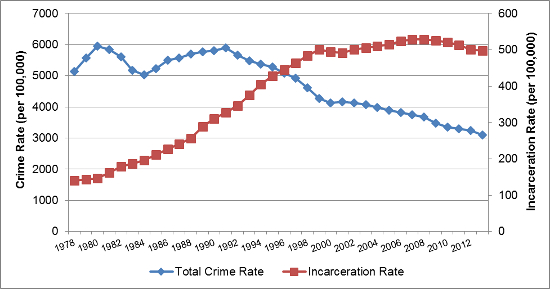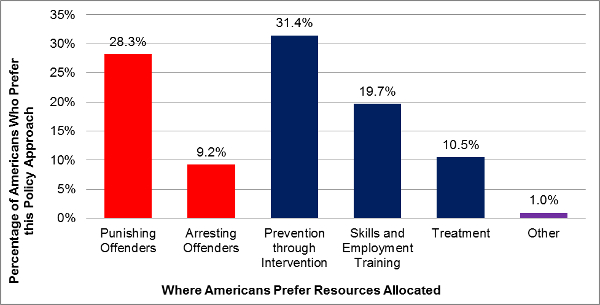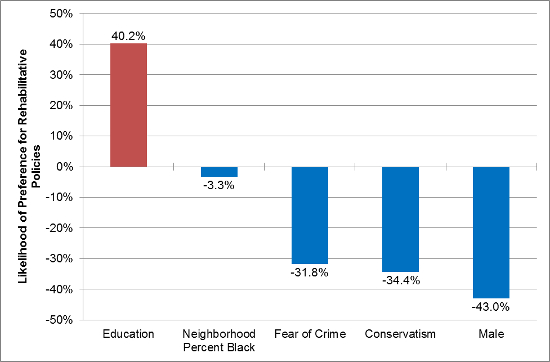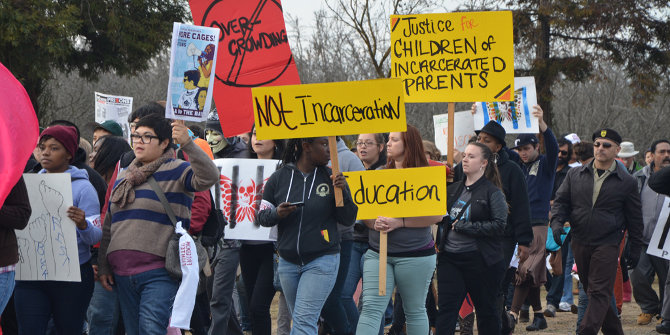 Crime rates in the US peaked more than two decades ago, yet the incarceration rate has continued to rise. Does this mean that Americans are more in favor of ‘tough on crime’ approaches to offending compared to rehabilitation? In new research, Thomas Baker tests this, finding that a majority actually prefer resources be allocated to rehabilitative rather than punitive criminal justice policies. Further exploring why people prefer one approach to the other, he finds that living in an area with more blacks, being afraid of crime, identifying as politically conservative, and being male increased the likelihood that people preferred more punitive policies.
Crime rates in the US peaked more than two decades ago, yet the incarceration rate has continued to rise. Does this mean that Americans are more in favor of ‘tough on crime’ approaches to offending compared to rehabilitation? In new research, Thomas Baker tests this, finding that a majority actually prefer resources be allocated to rehabilitative rather than punitive criminal justice policies. Further exploring why people prefer one approach to the other, he finds that living in an area with more blacks, being afraid of crime, identifying as politically conservative, and being male increased the likelihood that people preferred more punitive policies.
Recently, leading members of both the Democratic and Republican parties have come together in an attempt to pursue meaningful criminal justice reform. Proposed reforms have largely been aimed at reducing the prison population in the United States which began to rise in the 1970s when a “nothing works” in rehabilitation mentality took hold. Since then, the U.S. has been one of the most carceral states in the world, often leading all other nations in incarceration rate.
As Figure 1 shows, the proportion of Americans incarcerated in state and federal facilities grew every year between 1978 and 2008. In 1978 the incarceration rate was 141 per 100,000 Americans, in 2008 it peaked at 529 per 100,000 (though it has begun to decline slightly over the past several years). Some of this massive increase in incarceration can be attributed to the increasing rate of crime which began in the late 1960’s. However, the crime rate peaked in the early 1990s and has steadily declined since. Yet, the incarceration rate has continued climb. It has been assumed that the continued increase in incarceration is the result of Americans’ support for “tough-on-crime” politicians and Americans’ general support for punitive over rehabilitative ideologies.
Figure 1 – Crime Rate and Incarceration Rate in the U.S. 1978-2013

Sources: FBI, Uniform Crime Reports, prepared by the National Archive of Criminal Justice Data. Generated using the Uniform Crime Reporting Statistics at ucrdatatool.gov. Bureau of Justice Statistics. Prisoners under the jurisdiction of state and federal correctional authorities, December 31, 1978-2013. Generated using the Corrections Statistical Analysis Tool at www.bjs.gov.
To test the latter of these assumptions I recently conducted a study with several colleagues to evaluate whether Americans preferred criminal justice resources allocated to punitive or rehabilitative crime policies. Respondents were provided with five separate areas in which resources could be allocated: two punitive (punishing offenders and arresting offenders) and three rehabilitative (prevention through intervention, skills and employment training, and treatment). Respondents were also provided with an “other” category to which they could share any additional preferences beyond those offered (three respondents selected this category, all of whom indicated a preference for a rehabilitative policy such as “education”). The results presented in Figure 2 indicate that the most preferred area for resources to be allocated was “prevention through intervention” followed by “punishing offenders”. Taken together, as Figure 3 shows, the majority of Americans (62.54 percent) prefer resources be allocated to rehabilitative over punitive criminal justice policies.
Figure 2 – Where Americans Prefer Criminal Justice Resources Allocated

Figure 3 – Percentage of Americans Who Prefer Rehabilitative to Punitive Policies

Still, over one-third of respondents preferred punitive policies over rehabilitative policies leaving us to consider what factors may lead someone to prefer punitive policies. One key factor previously linked to punitive attitudes is fear of crime. As such, we evaluated two indicators of fear of criminal victimization—emotional fear and cognitive fear, in addition to several demographic and county level factors of respondents to see what impact these variables might have on support for rehabilitative versus punitive policies. In order to examine emotional fear we measured how afraid individuals were of being murdered, robbed or mugged, and having their home broken into. To measure cognitive fear of crime or what we call “victimization risk” we asked respondents how likely they thought it was that they would actually be the victim of a violent crime, the victim of a non-violent crime, and how much more likely they believed they were to be a victim of crime today versus a year ago. Along with these key indicators we examined the impact of respondents’ level of political conservatism, age, sex, education level, race, what region of the U.S. they lived in, and, given the link between racial threat and punitive attitudes, the percentage of people living in the respondent’s county who are black.
As Figure 4 shows, one factor, education, significantly increases the likelihood that someone will prefer rehabilitative policies over punitive policies. Four factors—neighborhood percent black, emotional fear of crime, conservatism, and being male—reduced the likelihood that respondents prefer rehabilitative over punitive crime policies. Stated differently living in an area with more blacks, being afraid of crime, identifying as politically conservative, and being male increased the likelihood that respondents preferred punitive policies.
Figure 4 – Effect of Significant Factors on Preference for Rehabilitative Versus Punitive Policies

These results provide key information for drawing several conclusions about Americans’ crime policy preferences and how policymakers should approach criminal justice reform. First, most Americans prefer rehabilitative over punitive crime policies. Second, those who prefer punitive policies largely do so because they are fearful of crime and, to a lesser extent, because they live in areas that have a larger percentage of residents who are black.
Given these findings, policymakers can be responsive to the preferences of a majority of Americans by supporting rehabilitative policies. To the extent that support for punitive policies extends from fear of criminal victimization, policy decisions promoting rehabilitative solutions to crime should be accompanied by attempts to assuage people’s fear of crime thus reducing the likelihood that they will oppose the policy. Policymakers who choose to align themselves with constituents who prefer more punitive criminal justice policies, should examine the sources of those preferences. Specifically, policymakers should consider the potentially racialized nature of punitive attitudes. That is, individuals living in counties that are a greater percent black may be more supportive of punitive policies as a means to socially control a population they deem threatening. Insofar as public support for punitive policies is driven by racial attitudes, policymakers should discount this support in favor of a more equitable approach to criminal justice policy.
This article is based on the paper ‘Examining Public Preferences for the Allocation of Resources to Rehabilitative Versus Punitive Crime Policies’, in Criminal Justice Policy Review.
Featured image credit: Daniel Arauz (Flickr, CC-BY-SA-2.0)
Please read our comments policy before commenting.
Note: This article gives the views of the author, and not the position of USAPP – American Politics and Policy, nor of the London School of Economics.
Shortened URL for this post: http://bit.ly/1Ubofo4
_________________________________
 Thomas Baker – University of Central Florida
Thomas Baker – University of Central Florida
Thomas Baker is an Assistant Professor in the Department of Criminal Justice at the University of Central Florida. His primary research interests focus on corrections with an emphasis on understanding the attitudes of correctional officers and inmates. Thomas also has research interests in criminal justice policy, especially correctional policy, and life-course criminology. His most recent work can be found in Law & Society Review, Criminology, Justice Quarterly, and Criminal Justice Policy Review.




